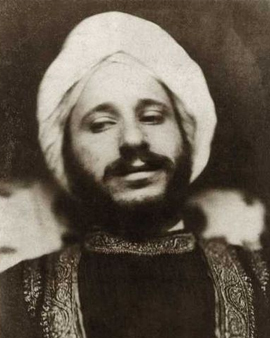Simeon Solomon (1840 - 1905) was born in London as the youngest of eight children of the famous Jewish couple Michael Solomon and Catherine Levy. His two siblings Abraham and Rebecca were also famous painters. It is therefore assumed that Abraham taught his younger brother the first basics before he was accepted at the Academy of the painter Carey. Later Simeon changed to the Royal Academy in London. There he met Dante Gabriel Rossetti, who introduced him to other followers of Pre-Raphaelism. Many Pre-Raphaelites admired Solomon's works and he soon became a member of the Pre-Raphaelite circle.
Solomon's early works often showed motifs from the Old Testament or scenic depictions of Jewish life and religious rituals, as in "Shadrach, Meshach and Abed-Nego". In addition, he also dealt with the medieval literary motifs typical of the Pre-Raphaelites. Through his association with Rosetti, Solomon made the acquaintance of the writer Algernon Swinburne, whose controversial novel Lesbia Brandon he illustrated. With Swinburne's influence, the themes in Solomon's pictures changed. He turned away from the Hebrew-influenced scenes and increasingly painted motifs from Roman-Greek antiquity. From this artistic phase, the painting "Habet!" in particular was greatly acclaimed by his contemporaries.
In 1873 Solomon's career came to an abrupt end. In that year he was picked up with another man in a public toilet in London. He was accused of homosexual acts, at that time generally summarized as sodomy. He got off with a fine at first. When he was arrested again in Paris the following year, he was sent to prison for three months. His reputation suffered as a result. He was no longer allowed to exhibit his works, which made it difficult for him to sell paintings. The artist scene soon forgot him. Only a few writers like Oscar Wilde or Walter Pater supported him and collected all his works. But the sensitive Solomon fell increasingly addicted to alcoholism and was finally committed to a so-called workhouse in 1884. There he continued to paint, but the alcohol had left its mark and his paintings never again reached the quality of his earlier works. Solomon died in poor circumstances as a result of his alcohol abuse.
×





.jpg)
.jpg)
 - (MeisterDrucke-243753).jpg)
 - (MeisterDrucke-243753).jpg)
.jpg)
.jpg)
.jpg)
.jpg)
.jpg)
.jpg)
.jpg)
.jpg)
.jpg)
.jpg)
.jpg)
.jpg)
.jpg)
.jpg)
.jpg)
.jpg)
.jpg)
.jpg)
.jpg)
.jpg)
.jpg)
.jpg)
.jpg)
.jpg)
 - (MeisterDrucke-234466).jpg)
 - (MeisterDrucke-234466).jpg)
_-_(MeisterDrucke-270844).jpg)
_-_(MeisterDrucke-270844).jpg)
.jpg)
.jpg)
.jpg)
.jpg)
.jpg)
.jpg)
.jpg)
.jpg)
 - (MeisterDrucke-564948).jpg)
 - (MeisterDrucke-564948).jpg)
.jpg)
.jpg)
.jpg)
.jpg)
.jpg)
.jpg)
.jpg)
.jpg)
.jpg)
.jpg)
.jpg)
.jpg)
.jpg)
.jpg)
.jpg)
.jpg)
.jpg)
.jpg)
.jpg)
.jpg)
.jpg)
.jpg)
 - (MeisterDrucke-209133).jpg)
 - (MeisterDrucke-209133).jpg)
.jpg)
.jpg)
.jpg)
.jpg)
.jpg)
.jpg)
.jpg)
.jpg)
.jpg)
.jpg)
.jpg)
.jpg)
 - (MeisterDrucke-280254).jpg)
 - (MeisterDrucke-280254).jpg)
.jpg)
.jpg)
.jpg)
.jpg)
.jpg)
.jpg)
.jpg)
.jpg)
 - (MeisterDrucke-602380).jpg)
 - (MeisterDrucke-602380).jpg)
 - (MeisterDrucke-597836).jpg)
 - (MeisterDrucke-597836).jpg)
.jpg)
.jpg)
.jpg)
.jpg)
.jpg)
.jpg)
.jpg)
.jpg)
.jpg)
.jpg)
.jpg)
.jpg)
.jpg)
.jpg)
_-_(MeisterDrucke-899724).jpg)
_-_(MeisterDrucke-899724).jpg)
 - (MeisterDrucke-191910).jpg)
 - (MeisterDrucke-191910).jpg)
.jpg)
.jpg)
_-_(MeisterDrucke-393182).jpg)
_-_(MeisterDrucke-393182).jpg)
 - (MeisterDrucke-571977).jpg)
 - (MeisterDrucke-571977).jpg)
.jpg)
.jpg)
_-_(MeisterDrucke-902507).jpg)
_-_(MeisterDrucke-902507).jpg)
.jpg)
.jpg)
 - (MeisterDrucke-273944).jpg)
 - (MeisterDrucke-273944).jpg)
.jpg)
.jpg)
.jpg)
.jpg)
.jpg)
.jpg)
.jpg)
.jpg)
.jpg)
.jpg)
.jpg)
.jpg)
.jpg)
.jpg)
.jpg)
.jpg)
.jpg)
.jpg)
.jpg)
.jpg)
 - (MeisterDrucke-556803).jpg)
 - (MeisterDrucke-556803).jpg)
.jpg)
.jpg)
.jpg)
.jpg)
.jpg)
.jpg)
.jpg)
.jpg)
_-_(MeisterDrucke-1427470).jpg)
_-_(MeisterDrucke-1427470).jpg)
.jpg)
.jpg)
.jpg)
.jpg)
.jpg)
.jpg)
.jpg)
.jpg)
.jpg)
.jpg)
.jpg)
.jpg)
.jpg)
.jpg)
.jpg)
.jpg)
.jpg)
.jpg)
.jpg)
.jpg)
.jpg)
.jpg)
.jpg)
.jpg)
.jpg)
.jpg)
.jpg)
.jpg)
.jpg)
.jpg)
 - (MeisterDrucke-571981).jpg)
 - (MeisterDrucke-571981).jpg)
.jpg)
.jpg)
.jpg)
.jpg)
 - (MeisterDrucke-221949).jpg)
 - (MeisterDrucke-221949).jpg)
.jpg)
.jpg)
_-_(MeisterDrucke-1408651).jpg)
_-_(MeisterDrucke-1408651).jpg)
.jpg)
.jpg)






